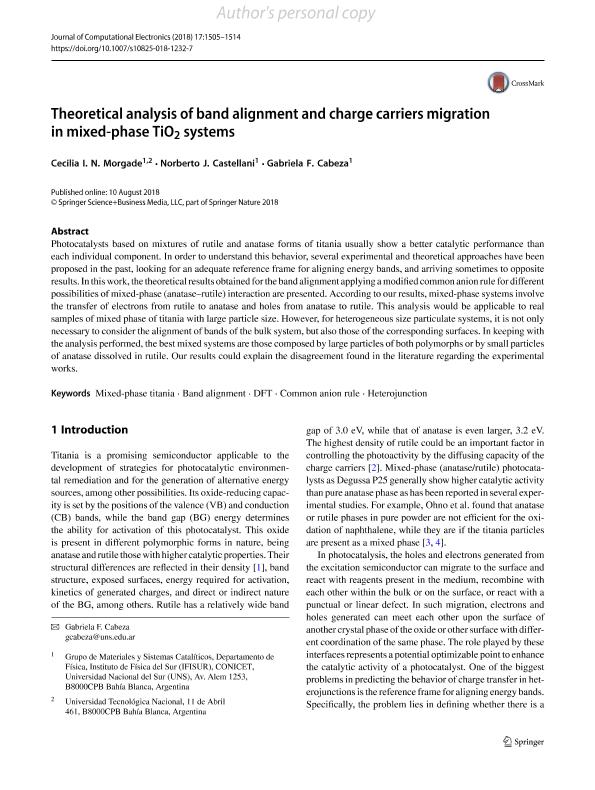Mostrar el registro sencillo del ítem
dc.contributor.author
Morgade, Cecilia Ines Nora

dc.contributor.author
Castellani, Norberto Jorge

dc.contributor.author
Cabeza, Gabriela Fernanda

dc.date.available
2020-01-15T16:09:35Z
dc.date.issued
2018-08-10
dc.identifier.citation
Morgade, Cecilia Ines Nora; Castellani, Norberto Jorge; Cabeza, Gabriela Fernanda; Theoretical analysis of band alignment and charge carriers migration in mixed-phase TiO2 systems; Springer New York LLC; Journal of Computational Electronics; 17; 4; 10-8-2018; 1505-1514
dc.identifier.issn
1569-8025
dc.identifier.uri
http://hdl.handle.net/11336/94745
dc.description.abstract
Photocatalysts based on mixtures of rutile and anatase forms of titania usually show a better catalytic performance than each individual component. In order to understand this behavior, several experimental and theoretical approaches have been proposed in the past, looking for an adequate reference frame for aligning energy bands, and arriving sometimes to opposite results. In this work, the theoretical results obtained for the band alignment applying a modified common anion rule for different possibilities of mixed-phase (anatase–rutile) interaction are presented. According to our results, mixed-phase systems involve the transfer of electrons from rutile to anatase and holes from anatase to rutile. This analysis would be applicable to real samples of mixed phase of titania with large particle size. However, for heterogeneous size particulate systems, it is not only necessary to consider the alignment of bands of the bulk system, but also those of the corresponding surfaces. In keeping with the analysis performed, the best mixed systems are those composed by large particles of both polymorphs or by small particles of anatase dissolved in rutile. Our results could explain the disagreement found in the literature regarding the experimental works.
dc.format
application/pdf
dc.language.iso
eng
dc.publisher
Springer New York LLC
dc.rights
info:eu-repo/semantics/openAccess
dc.rights.uri
https://creativecommons.org/licenses/by-nc-sa/2.5/ar/
dc.subject
MIXED-PHASE TITANIA
dc.subject
BAND ALIGNMENT
dc.subject
DFT
dc.subject
COMMON ANION RULE
dc.subject.classification
Física Atómica, Molecular y Química

dc.subject.classification
Ciencias Físicas

dc.subject.classification
CIENCIAS NATURALES Y EXACTAS

dc.title
Theoretical analysis of band alignment and charge carriers migration in mixed-phase TiO2 systems
dc.type
info:eu-repo/semantics/article
dc.type
info:ar-repo/semantics/artículo
dc.type
info:eu-repo/semantics/publishedVersion
dc.date.updated
2019-10-22T17:36:07Z
dc.identifier.eissn
1572-8137
dc.journal.volume
17
dc.journal.number
4
dc.journal.pagination
1505-1514
dc.journal.pais
Alemania

dc.journal.ciudad
Berlin
dc.description.fil
Fil: Morgade, Cecilia Ines Nora. Universidad Nacional del Sur. Departamento de Física; Argentina
dc.description.fil
Fil: Norberto J. Castellani. Consejo Nacional de Investigaciones Científicas y Técnicas. Centro Científico Tecnológico Conicet - Bahía Blanca. Instituto de Física del Sur. Universidad Nacional del Sur. Departamento de Física. Instituto de Física del Sur; Argentina
dc.description.fil
Fil: Gabriela F. Cabeza. Consejo Nacional de Investigaciones Científicas y Técnicas. Centro Científico Tecnológico Conicet - Bahía Blanca. Instituto de Física del Sur. Universidad Nacional del Sur. Departamento de Física. Instituto de Física del Sur; Argentina
dc.journal.title
Journal of Computational Electronics
dc.relation.alternativeid
info:eu-repo/semantics/altIdentifier/url/https://link.springer.com/article/10.1007/s10825-018-1232-7
dc.relation.alternativeid
info:eu-repo/semantics/altIdentifier/doi/http://dx.doi.org/10.1007/s10825-018-1232-7
Archivos asociados
